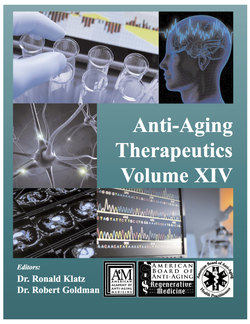Читать книгу Anti-Aging Therapeutics Volume XIV - A4M American Academy - Страница 7
На сайте Литреса книга снята с продажи.
INTRODUCTION
ОглавлениеA key feature of facial aging is loss of volume, both of fat and bone. Attempts to create a more youthful looking face should address these components to be successful. Autologous fat holds appeal for this purpose due to the absence of tissue rejection and allergic reactions. Autologous fat is also readily available in many patients, and can be obtained from lipoaspiration performed under local anesthesia.
Autologous fat transfer has been used surgically for a century and for a quarter of a century using lipoaspirate. More recently, techniques have focused on maintaining adipocyte viability by minimizing trauma, resulting in increased graph survival.1-4 This paper introduces the concept of cell-assisted fat transfer, a complementary approach that augments gentle harvest and implantation techniques with adipose derived mesenchymal stem cells (ADSCs) and growth factors from platelet rich plasma (PRP).
Stem cells have the characteristics of both replicating themselves and differentiating into a variety of other cells. Embryonic stem cells are found in the blastocyst 5 to 6 days post fertilization and are truly pluripotent, meaning that they can differentiate into any type of mature cell. These cells require sterile culture, tissue expansion, and differentiation prior to any therapeutic use and the usage of embryonic stem cells remains controversial on a bioethical level. Conversely, adult mesenchymal stem cells are found in many tissues, including bone marrow and adipose tissue,5 and are multipotent, meaning that they can differentiate into many different cell types, including vascular tissue, bone, cartilage, and fat. In addition to their cellular regenerative potential, they also exhibit chemotaxis and the ability to modulate inflammation.6-8
Adipose tissue is a rich source of adult stem cells – as much as 500 times the concentration found in bone marrow. Subcutaneous fat is a source of both the adipocytes and ADSCs used in this procedure. ADSCs are available in large quantities and can be harvested in a simple procedure under local anesthesia.9,10 The growth factors: epithelial growth factor (EGF), platelet derived growth factor (PDGF), transforming growth factor beta (TGF-beta), vascular endothelial growth factor (VEGF), and fibroblast growth factor (FGF) are present in increased concentrations in the platelet rich fraction of plasma obtained from peripheral blood.
Among the changes of aging and environmental damage seen in the face are loss of volume of both fat and bone, decreased collagen with the impairment of light reflex (brightness), skin laxity, and surface irregularities. With the exception of laxity, all of these changes can be addressed with cell-assisted facial fat transfer.10,11 Figures 1 and 2 illustrate the improvements achievable with cell-assisted facial fat transfer.
Figure 1. 59-Year-Old Male Before (left) and After (right) Undergoing Cell-Assisted Facial Fat Transfer
Figure 2. 47-Year-Old Female Before (left) and After (right) Undergoing Cell-Assisted Facial Fat Transfer
